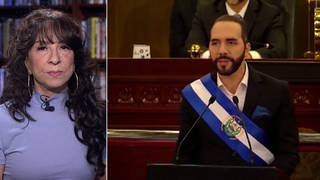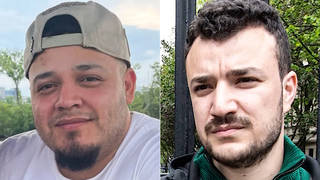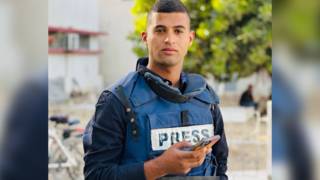
A new report from the Committee to Protect Journalists found that at least 55 journalists were killed this year in direct connection to their work. The most violent country was Iraq, where 32 journalists lost their lives. [includes rush transcript]
Transcript
JUAN GONZÁLEZ: Today, on our last broadcast for 2006, Democracy Now! takes a look at the number of journalists killed this past year. A new report by the Committee to Protect Journalists finds 2006 to be one of the most dangerous years for journalists ever. Fifty-five journalists were killed in direct connection to their work. In Iraq alone, violence claimed the lives of 32 journalists. It was the highest yearly death toll recorded by the organization so far in Iraq or, in fact, any country in a single year.
AMY GOODMAN: Murder was the leading cause of journalist deaths around the world. The CPJ report determined that less than 15 percent of journalist murders result in convictions of their perpetrators.
Frank Smyth is with us now, the journalist security coordinator for the Committee to Protect Journalists. He joins us from Washington, D.C.
Welcome to Democracy Now!, Frank.
FRANK SMYTH: Thank you, Amy.
AMY GOODMAN: It’s great to have you with us. In fact, Frank, you, yourself, before we talk about this year, were a victim of a kidnapping, your colleague killed during Desert Storm, is that right?
FRANK SMYTH: Well, we were actually captured while embedded with Kurdish rebels trying to overthrow Saddam Hussein, and were held—weren’t kidnapped necessarily, but captured and held incommunicado before being released.
JUAN GONZÁLEZ: And could you tell us, in summary, what some of the most troubling findings of this year’s report were?
FRANK SMYTH: The most troubling finding is, number one, is that the death rate in Iraq is increasing, rising to 32, which is a record so far since the U.S.-led invasion in 2003. And in addition, 28 of the 32 journalists killed in Iraq in 2006 were outright murdered, by insurgent or other irregular forces, and almost all of them were Iraqis. So, we started seeing murders a few years ago in Iraq of journalists, but now 61 percent of journalists being killed in Iraq have been murdered. And that’s a disturbing and rising trend.
JUAN GONZÁLEZ: I also noticed in your report that, as you mentioned, overwhelmingly most of the journalists killed were Iraqis. Does that mean that basically there’s been an enormous pullout of foreign journalists from the coverage, or is it that the Iraqis are being targeted more?
FRANK SMYTH: I think it’s both. I think you have less foreign correspondents operating in Iraq, and those that are operating are rarely venturing beyond the Green Zone areas, near the Green Zone, to avoid being kidnapped, as was the case with Jill Carroll. At the same time, you see an increasing number of journalists being targeted merely for doing their work, whether they’re working for U.S.-backed media, Western media, or independent Iraqi media that’s emerged in the past few years.
JUAN GONZÁLEZ: And I’d like to ask, in terms of those Iraqi journalists who were killed, were most of them working for Iraqi news organizations, or were these a lot of Iraqi journalists who have since been hired by foreign news organizations?
FRANK SMYTH: Most of them in 2006 were working for Iraqi news organizations.
AMY GOODMAN: The number of Western journalists, of course, in Iraq has gone down, with the dangers. In the last few years, though, there have been also a number killed by U.S. troops, like, well, what Reuters described as one of the leading conflict cameramen of our time, Mazen Dana, killed by U.S. troops outside Abu Ghraib. Then there was the Al Jazeera reporter Tareq Ayyoub. The U.S. military shelled the area around the Al Jazeera office where he was on the roof. He was killed. What kind of tone do you think that set early on, as we lead up to this point where the bulk of the deaths are as a result of, well, you write in the Committee to Protect Journalists, insurgents?
FRANK SMYTH: The incidences involving U.S. forces, in particular the shooting of Mazen Dana, was especially disturbing, because he was shot at relatively short range in a situation where it called into question the rules of engagement. We protested and asked for clarification from the Pentagon about that shooting in particular, and the Pentagon eventually did a comprehensive report and investigation of the shooting, which exonerated the soldiers involved. But the report itself encouraged the Pentagon to review its own rules of engagement so that U.S. forces would be made aware of the right and presence of journalists to operate on the battlefield. And the Pentagon has never acknowledged whether or not it’s followed its own recommendations. But we’ve sent a number of letters to former Secretary Rumsfeld and other officials, encouraging them to follow that report’s recommendations and to make U.S. troops aware of the right and presence of journalists to operate on the battlefield.
AMY GOODMAN: Of course, perhaps the most famous U.S. attack on journalists was the shelling of the Palestine Hotel, where hundreds of unembedded reporters were and two cameramen were killed—Taras Protsyuk of Reuters—he came from the Ukraine—and José Couso. This was right—the day before the U.S. forces took Baghdad and pulled down that statue of Saddam Hussein. Just in the last few weeks, a Spanish judge has ruled that the U.S. soldiers involved in the killing of José Couso could be—could be subpoenaed or indicted.
FRANK SMYTH: There are two issues there. One is the issue of the soldiers that operated on the ground, and the U.S. military also did an investigation of that incident, one of the—those are the few cases where the U.S. military has conducted its own investigations, and again exonerated the soldiers on the ground. But the issue that remains unresolved is: Why wasn’t information about the fact that that hotel was filled with journalists communicated to troops on the ground? The U.S. military’s own investigation never looked at the command-and-control issues that were illustrated by that tragedy.
JUAN GONZÁLEZ: Frank Smyth, I’d like to ask you about other countries in your report. I think you list the Philippines, Afghanistan, of course Colombia, which has traditionally been one of the most dangerous countries in the world. Could you talk about some of the major cases that you covered that occurred this year there?
FRANK SMYTH: Sure. One of them, in the Philippines we’ve seen a number of murders for many years, most of which have gone unresolved. Overall, one thing to point out is that 61 percent of the journalists killed in Iraq since 2003 have been murdered. The actual worldwide level of murders is higher: 70 percent of all journalists killed worldwide over the past 15 years have in fact been outright murdered. And the Philippines now is near at the top of the list. You also have had cases like Hayatullah Khan, a journalist in Pakistan who disappeared for a number of weeks before his body was discovered, and he had been murdered, we believe, in retaliation for his work. So we’ve see journalists—
AMY GOODMAN: Can you—Frank—
FRANK SMYTH: Yes.
AMY GOODMAN: Can you talk more about that? That was very significant, what he was investigating.
FRANK SMYTH: Well, he was investigating a U.S. military airstrike. According to family members and his colleagues, he then disappeared. We made inquiries attempting to find out who might have him. It was very difficult to get any cooperation, and eventually his corpse was discovered. He had been murdered. And we believe that he was killed in retaliation for his work, and his investigation into that airstrike, in particular, looks like the most likely cause.
AMY GOODMAN: Can you talk about the Russian journalist who was killed most recently, this year, that leads up to the latest scandal that we’re seeing unfold now in Britain with the former Russian spy?
FRANK SMYTH: Well, the journalist—the most recent journalist killed in Russia is one of about a dozen journalists that we believe have been murdered in retaliation for their work in recent years, one of them being the former U.S. journalist and Forbes correspondent Paul Klebnikov. But you’ve seen a number of journalists being murdered in Russia, in particular, investigative journalists, whether they are foreigners or Russian journalists. And the impunity rate, so far none of those crimes have been resolved. And overall, worldwide, over the past 15 years, the impunity rate for murdered journalists is about 85 percent, unfortunately.
JUAN GONZÁLEZ: Now, in terms of Colombia and Latin America, it appears on the surface that things are improving in some those countries in terms of the—some have had very high rates of murders of journalists. Could you comment on that?
FRANK SMYTH: Well, they say it’s improving. In a place like Colombia, after so many journalists have been murdered with almost complete impunity over the years, you don’t need to murder that many more journalists to keep journalists from wanting to investigate difficult or sensitive matters, especially human rights abuses or ties between military and paramilitary forces that have been responsible for a great deal of violence against journalists. So the fact that the number of Colombian journalists being murdered is not as high now as it was five or 10 years ago isn’t necessarily indicative of much of an improvement. I think you still have the lingering effect of the residue of that previous violence, and in Colombia there are very few investigative journalists left that are really looking at those kinds of issues. And the few journalists that are left—Ignacio Gómez, Hollman Morris—have themselves been subject to death threats and have periodically been forced to leave the country.
AMY GOODMAN: Back on the issue of Russia, in the case of Anna Politkovskaya, the Russian journalist who was killed, leading investigative journalist and critic of the state, specifically President Vladimir Putin, shot contract-style in her Moscow apartment on October 7th. Can you talk more about that and the holding of the state responsible?
FRANK SMYTH: Well, that was a case that remains under investigation. It’s not uncommon. And it’s unclear exactly what the motivation was. But certainly she did enterprising, groundbreaking work in investigating abuses in Chechnya involving Russian and other forces. So we believe that her work in Chechnya may well be responsible or what led to perpetrators to then murder her. But that kind of gangland-style, Mafia-style assassination is quite common in Russia, like it is in many other nations. And certainly, whether or not it involves security forces is still unclear, but the problem is, is that very few of those kinds of murders of journalists in Russia, as in many other places, end up being resolved.
AMY GOODMAN: Frank Smyth, I wanted to ask you about a story that didn’t get very much coverage this week. We heard a lot about one of the last acts of the U.N. Security Council in imposing sanctions against Iran. But on that same day, last Saturday, the U.N. Security Council approved an unprecedented resolution that condemned attacks on journalists and urged countries to protect journalists. Can you talk more about that act of the U.N. Security Council?
FRANK SMYTH: Yes, Amy. This was a resolution that was brought forward by the International Federation of Journalists, a journalist federation of unions, the International News Safety Institute, of which the Committee to Protect Journalists that I work for is a member of, and also the European Broadcasters Union. And it was an effort to pass a resolution that would underscore the right and duty of journalists to be able to operate in armed conflicts, covering armed conflicts, without fear of being targeted or victimized by state or other forces. And one of the most important parts of the U.N. resolution was to underscore in one of the operative paragraphs that broadcast facilities, that media facilities must be considered civilian entities and may not be considered military targets unless there is some specific reason to target them in a military manner. And coming in the wake of U.S. attacks involving Al Jazeera, the Kabul bureau, in 2001 in Afghanistan, that Ron Suskind reported earlier this summer was a deliberate attack, according to his sources, which he did not name, on Al Jazeera—coming in the wake of those kind of attacks, this resolution and that particular language is very important, and it underscores that media outlets must be considered civilian entities and not be targeted for military purposes.
AMY GOODMAN: Frank Smyth, again, I want to thank you very much for being with us, of the Committee to Protect Journalists, just put out their report. The 2006 tally in Iraq is the highest in a single country since the Committee to Protect Journalists was founded in 1981, of journalists killed. The second deadliest year was 2004. Again, that was journalists killed in Iraq, only matched in 1995 in Algeria, both of which saw 24 journalists killed. This is Democracy Now!, democracynow.org, The War and Peace Report. We’ll be back in a minute.












Media Options